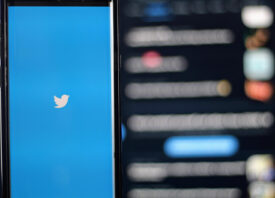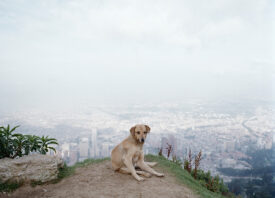Search this site
Understanding the Role of Twitter in the NFT Space

Last year, the photographer TJ Thorne sold out the entirety of his Ebb and Flow collection, a series of 100 1:1 NFTs, during a Twitter Space hosted by his friend, NFT tastemaker DeeZe. “He gave me an audience and a stage to tell my story and what the images mean to me,” the artist remembers. “What happened after that was just magic in my eyes.”
It’s a story you might know already. But here’s what you might not know: Thorne initially minted his first NFTs on OpenSea in March, the same month NFTs launched head-first into the mainstream consciousness with the $69 million Beeple sale at Christie’s. Very few photography projects had entered the space yet. “I had no idea that there was an NFT community, and I had no idea that most everything took place on Twitter, which I didn’t use,” the artist admits now. “Since I had no idea how to sell those first NFTs, I ended up deleting them.”
Two months later, a friend reached out to Thorne with news: NFT collectors were starting to invest in photography. “He told me that everything took place on Twitter, so I dusted off my Twitter account that I had never used, and I jumped back in,” Thorne remembers now. The rest is history.
There are a few reasons why Twitter has proven so influential in the NFT Space. To understand them, it’s best to start at the beginning–and, arguably, with profile pics, or PFPs. Some of the earliest NFT projects gained momentum as PFPs, including the now-famous CryptoPunks by Larva Labs, launched in 2017. In April of 2021, Bored Ape Yacht Club launched. In September of 2021, Christie’s Hong Kong announced an auction devoted to PFP NFTs.
These projects have thousands of images, each with unique traits; some are rarer, and therefore more valuable, drawing comparisons to the Pokémon cards of yesteryear. Of course, they’ve also become status symbols.
Last April, you could get a Bored Ape NFT for $200. One year later, you’d have to shell out $420,000 to join the exclusive club, famed for its celebrity collectors, including Jimmy Fallon, Paris Hilton, and Madonna. Fans dream of being able to snag a rare Ape, such as one with laser eyes or solid gold fur, making the collection feel especially aspirational.
But it’s not only about showing off your expensive wares. Beyond the artwork itself and the communities build around it, part of the appeal of these projects is that collectors can show off their NFTs in the form of social media avatars, including their Twitter profile pictures.
For many, then, NFTs have become a means of expressing personal identities–and of connecting with people following a global pandemic that left many of us isolated. On Twitter, where it’s easy to get lost in information overload, today’s artists and collectors signal to each other using profile pictures on Twitter, while at the same time declaring their membership as part of a larger group. Holders of some of these collections, like Bored Apes, get together and make connections, in-person and in the metaverse. For many, it’s about the social aspect more than the artwork itself.
On Twitter, live audio conversations are also a major component. Twitter Spaces have been around since 2020, but in October 2021, it reached the masses, with any Twitter user able to create and host their own conversations. The NFT community had already been active on Clubhouse, so audio chats were second-nature. With Spaces, Twitter helped bridge the gap between the crypto community and the art world, albeit with a more casual vibe.
The NFT space moves at breakneck speed, but Twitter Spaces foster in-depth conversations with artists and collectors. Some spaces give artists room to “shill” their work, while others mark the launch of new projects, reveal parties, or surprise drops. At the same time, others delve into complex topics like how smart contracts work, why some projects sell out and others remain underrecognized, and what gallery spaces might look like in the metaverse.
In time, photographers migrated over to Twitter, bringing a new perspective to conversations already swirling around the NFT space. NFT collectors could find new artists on Twitter, and photographers could communicate with them one-on-one, without the need for the kinds of “gatekeepers” we see in the traditional art world.
Even for artists new to Twitter, the platform felt more accessible than other social channels. “When I hopped over to Twitter Spaces, almost overnight, I got to actually meet and personally talk with people I’ve followed for ages,” Chris Hytha, the photographer behind the Rowhomes NFT collection, tells us. “I feel that for a lot of photographers, Instagram has become very business-like. You have to plan your grid, and you can’t post anything that’s not in your ‘style.’ You set up all these rules for yourself. But in the last year, Twitter became a place where we could be free and just speak our minds.”
Perhaps most of all, Twitter has become a place where artists can support other artists and lift each other up. Dave Krugman, the creator of DRIVE, regularly hosts “races” on Twitter, where his followers can compete by shooting photos in the style of the collection or creating derivative artworks. In that sense, the collectors are able to become artists themselves, expanding on the original work. Krugman’s races aren’t limited to NFT holders, either; anyone can participate.
In many ways, this ethos of sharing is baked into the platform itself. “Twitter has the best feature that Instagram does not, the ‘re-tweet’ button, which many value as the secret weapon to sharing other artists’ art,” Jessica Cardelucci, the photographer behind the Wild Mustangs NFT collection, tells us. “Twitter allows us to not only share our own work, but become curators ourselves by easily re-sharing other artist’s work we find and love.”
While Twitter can help foster these long-term connections and support systems, it also has its drawbacks. As the photographer and collector Natalie Christensen explained in a recent Twitter Spaces conversation hosted by Feature Shoot, Twitter can also be fertile ground for comparisons with other artists, including those who might appear to be selling more or attaining more success in the space.
It can feel overwhelming and all-consuming; some describe it as full-time job. “When I started with NFTs last year, I spent almost every waking hour on Twitter, for fear of missing something important or fear of being memory holed,” photographer Hans Kemp, who created the Bikes of Burden collection, admits. “I can’t do that anymore, and that’s okay. Everyone has a different philosophy of life of course, but I didn’t escape the rat race by devoting my life to my photography passion to now end up being trapped in the FUD and FOMO of the NFT space. I want to enjoy life and continue documenting it with a sense of wonder. And I want to transfer this sense to people out there, and NFTs are allowing me to continue to do this.”
(NFT Twitter also has its own language. FUD stands for “fear, uncertainty, and doubt,” and FOMO stands for “fear of missing out.”)
At its worst, Twitter breeds FUD and FOMO, but at it’s best, it’s a place where artists can be themselves and find people who relate to their work, even if they’re halfway across the world. “I’m not sure what makes the Ebb and Flow collection so well-suited for NFTs, but I’m glad that people connected with my story,” TJ Thorne tells me.
“My advice is simple: be genuine. Be a good person. Support others, and try to add value not just to the NFT space but to the world in general. It’s easy to get deep into this stuff and to run your mental health ragged. So you need to take care of yourself and not let your emotions be controlled by all of the ups and downs. I think remaining true to your creative spirit and never forgetting why you started to point a camera at things are important.”



